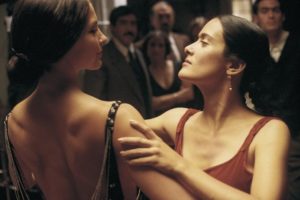
I fell for Frida Kahlo in an instant. It was the tango that did it as Salma Hayek and Ashley Judd strutted, stamped and slid across the floor and each others bodies in two minutes of intense passion.
Knowing this was a transcendent moment without completely understanding what the word meant, I sensed that Spirit had arrived, wild, mysterious and unmistakable.
Expressing this creative Spirit that allows us a glimpse of God can be precarious and dangerous, especially when we insist on drawing, writing, singing and acting outside the lines society has drawn in a futile attempt to keep chaos tamed. Sometimes the attention is positive, but equally, a sense of not being good enough creeps and crawls around the psyche in the face of destructive criticism.
Success spirals into despair when you wonder if you can ever again create a thing of even marginal beauty or a moment of transcendence. Self destruction can become normalised. A drink or two there, a fancy new drug to keep nihilism at bay, starving and taming the body into disappearing as sacrifice to the inner demons, all the while dulling the Spirit that aches for expression.
Elizabeth Gilbert, author of Eat, Pray, Love suggests that there is another more ancient way to see the creative process instead of assuming that it must be linked with suffering. She explored the ideas of ancient Greece and Rome to come up with a way of distancing herself from her own tortuous creative process.
She points out that the Greeks thought there was a divine attendant spirit (daemon) at work from a distant and unknown source. Like ET visiting from the wider universe to tap away on my keyboard. Whereas, the Romans figured that a genius or a magical divine entity lived in the walls of an artist’s studio coming out from time to time to assist with the work. Your own friendly house ghost lounging about in an inspirational way.
Under this system, no-one could get too big for their boots because it was never all their own work. And if your creation was a complete disaster, it was probably because your genius was a bit inferior and you needed to trade up to a newer model. All this changed at the Renaissance when the individual became the centre of the universe and the genius entered the individual, which Gilbert says, was like asking someone to swallow the sun. She reckons that the pressure has been killing off artists ever since.
Gilbert’s recovered idea from the ancients makes perfect sense to me. For in all the ancient stories the Spirit moves where it wills, wild, mysterious yet unmistakable and existing despite human belief or lack of it. So why would it be any different today?
Not that I think there’s something living in the walls of my house, or that there’s a daemon, other than The Labrador, lurking round my feet; instead the idea offers an expansive mythology. Not an answer to how the words appear on the page when I sit down with absolutely nothing in my head, but a way of seeing creativity like a tango with the Divine Spirit, a much more complex and incomprehensible engagement than I ever imagined.
Truth told, knowing that we are always in the presence of the Divine and not just gaining imperfect glimpses might make the creative process more complex, more intense; a fragile interaction of Spirit and self too good to be true. And yet I’m reminded of the fleeting transcendent union of Salma and Ashley, spirited, unmistakable, wild and mysterious, perhaps divine.
First version published May 2010 and in Spirited Exchanges, June 2010

My favorite clip ever. Why I want to learn to tango. Divine intensity. Intimacy as perfection of presence. The dance of the stuggle with the spirit. Give Kali a hung. Be well.
After travelling to Argentina I did do some lesson in street tango. Sublime. Amazing how we humans can co-create divine experiences through intense movement and connection.